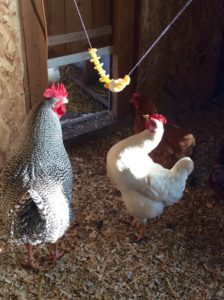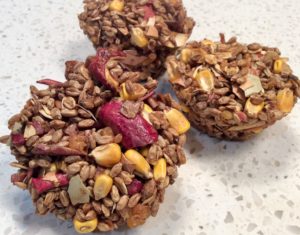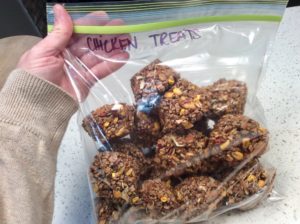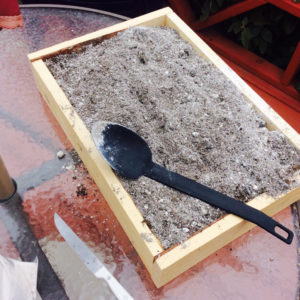
A long winter certainly makes it difficult for chickens to forage, free-range and frolic. Snowy confinement combined with frigid temps can exacerbate boredom that can quickly turn into pecking or other bad habits.
As we head into the early stages of winter, I know I need to be creative in order to keep 18 cooped up chickens occupied. To minimize bad behavior, I recognized one motivator sure to keep their attention…food.
TREATS
When snow becomes too deep to foray outside, I encourage my birds to scratch and peck their way around the enclosed outdoor pen. Utilizing scratch grains hidden within the ground litter allows them to do what comes naturally.
Beyond keeping them active, the floor remains turned and dry. This area now becomes the only space in which my birds can find food during their awake hours outside the coop.
A few have argued that feeding scratch grains short changes birds on many nutritive requirements. Although there is some truth to this fact, I feed very little scratch grain which keeps my birds on the hunt. Nutritionally balanced layer pellets are always available as their main winter food source.
One aspect of keeping your flock happy is to mimic the behaviors and feeding habits they’d likely be engaged in during warmer months. For instance, with a little forethought, buckets of semi-dry compost filled with leaves, earthworms or ants could serve as a wonderful activity. Chickens most certainly would go crazy to scratch through a mound of wriggly, high-protein bugs during a long winter. This could be a great option for those with space to nurture vermiculture.
If live bugs aren’t your cup of tea, utilize dry bugs as a fun treat. Mealworms, crickets, grasshoppers or ants, the chickens will love them and you! I order my mealworms online in order to get the best deal.
With snow covering the ground, a brilliant way to add a few greens into your flock’s diet is by providing dry alfalfa. I’d suggest adding it to a hanging feeder or tying it up so your birds can pluck and pull with ease. If you keep it just within reach, they will have to stretch to get at this tasty treat.
Hanging treats are simple to employ year-round to help combat boredom. It forces the chickens to focus on something out of the ordinary: their bodies and brains are otherwise occupied.
Last year I tried stringing up treats and my birds went crazy. It was fun to watch them learn from each other as they jumped to grab pieces of grape or a hard-boiled egg.

Stringing other foods, such as cabbage, corn on the cob, cucumbers or zucchini, can prove to be equally as fun but low on protein. To balance out the nutritional value, while providing body-warming carbohydrates, consider making a homemade seed block.
Various recipes can be found all over the internet, and many of them use gelatin to hold things together. I chose to take a different route by utilizing egg whites as my binder.
Egg whites add a level of protein I always have on hand. Not only is egg white easy on the pocketbook, but it also boosts the nutrition levels up another notch.
25 ACRE BASIC SEED BLOCK RECIPE

My basic recipe consists of approximately 5-6 cups dry ingredients,12 egg whites and a dash of molasses. In the photo, I used a blend of wheat, whole field corn, dehydrated sweet corn, flax meal, rolled oats, cat food, dried oregano, cayenne pepper, dehydrated apple pieces (no seeds) and dry eggshells.

1. Start by whipping 12 egg whites just until frothy. Fold in the dry ingredients and add 1 tablespoon of molasses.


2. Scoop the mixture into silicone muffin cups, packing the “batter” tightly. A loaf pan can also be used. Just remember, a larger volume of seed mixture requires much more time in the oven to dry. If too much moisture remains in your block, it is likely to crumble.
3. Bake on the lowest oven setting; which for me is 170 degrees, for 60-90 minutes, until dry. Allow to cool completely before removing the finished seed block from your pan or cups.

Give to your chickens as a fun treat during the winter or anytime they need a little boost!
These blocks can also be strung together for an irresistible hanging treat. Various other dried vegetables, fruits, herbs, and grains can be added to your seed block. For instance, don’t be afraid to mix in a few dried mealworms or raisins.
Just make sure the moisture content is super low if you plan on making these shelf-stable. Otherwise, just pop them into the freezer for safe, long-term storage.
For a fresh addition to your chicken’s winter diet, try sprouts. Just about any seed can be turned into a deliciously nutritious treat if given a little water and time. In the past, I’ve used sprouting lentils, alfalfa seed or even seeds taken from my scratch bin.
ACTIVITIES
Beyond keeping your chickens active by catering to their stomachs, you can try other activities. Throughout the winter, don’t be afraid to change up your chicken’s daytime space. If you are able, move around feeding areas, bathing boxes, perches or add a chicken swing.
Give them spaces to explore and new things to hop onto…or into. One of my favorites is a super simple dust bath. The recipe below will help keep your birds pest and mite-free over the blustery winter. Just place your box in a sunny area and watch as your hens discover their version of a spa retreat!
25 ACRE CHICKEN DUST BATH

Mix equal parts of:
- Sand
- Ashes (wood stove or campfire ashes)
- Soil
- Diatomaceous earth (food grade)
Add this mixture to a low-profile box that is large enough for 1 chicken to roll around in.
No matter what treats or activity you decide on, your flock will not argue. They will be happier and healthier for it. Even if you simply sit and visit, share some kitchen scraps and talk to them. Trust me, they will love it!












